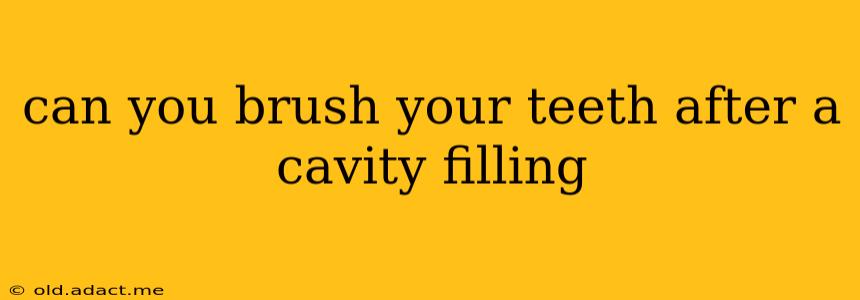Can You Brush Your Teeth After a Cavity Filling?
Yes, you can brush your teeth after a cavity filling, but it's crucial to do so gently and with the right technique. The immediate post-filling period is delicate, and improper brushing could dislodge the filling or irritate the sensitive area. This guide explains the best practices for brushing your teeth after a cavity filling, addressing common concerns and questions.
When Can I Brush My Teeth After a Filling?
Most dentists recommend waiting at least two hours after getting a filling before brushing your teeth. This allows the filling material to properly set and harden. Some newer filling materials might require a slightly longer waiting period, so it's best to follow your dentist's specific instructions. Rushing the process could compromise the longevity and stability of your filling.
How Should I Brush My Teeth After a Filling?
Gentle is the key word here. Avoid aggressive scrubbing, especially around the newly filled area. Use a soft-bristled toothbrush and a fluoride toothpaste. Brush with short, gentle strokes, focusing on proper brushing technique rather than harsh pressure.
What if My Teeth Feel Sensitive After a Filling?
Sensitivity after a filling is quite common and usually subsides within a few days. If the sensitivity persists or worsens, contact your dentist. In the meantime, you can use a desensitizing toothpaste to help alleviate the discomfort. Avoid extremely hot or cold foods and drinks, as these can exacerbate sensitivity.
Can I Use Mouthwash After a Filling?
Generally, it's safe to use mouthwash after a filling once the filling has fully set (again, typically after two hours). However, avoid alcohol-based mouthwashes, as they can irritate the area. Opt for a fluoride mouthwash to help strengthen your enamel and prevent future cavities.
What if My Filling Feels Loose or Jagged?
If you notice any abnormalities with your filling, such as looseness or jagged edges, contact your dentist immediately. Don't attempt to fix it yourself. A loose or damaged filling can lead to further dental problems.
How Often Should I Brush My Teeth After a Filling?
Maintain your regular oral hygiene routine, which ideally involves brushing twice a day for two minutes each time. Consistent brushing helps prevent future cavities and ensures the long-term health of your teeth and gums.
What Kind of Toothbrush Should I Use?
A soft-bristled toothbrush is essential to prevent damage to the newly placed filling and to avoid irritating sensitive teeth. Replace your toothbrush every three to four months, or sooner if the bristles become frayed.
Is flossing important after a cavity filling?
Absolutely! Flossing remains crucial for maintaining good oral hygiene, even after a filling. Be extra gentle when flossing around the filled area to avoid dislodging the filling.
By following these guidelines, you can ensure proper aftercare for your cavity filling and maintain optimal oral health. Remember, consulting your dentist with any concerns is always the best course of action. They can provide personalized advice based on your specific situation and the type of filling material used.
